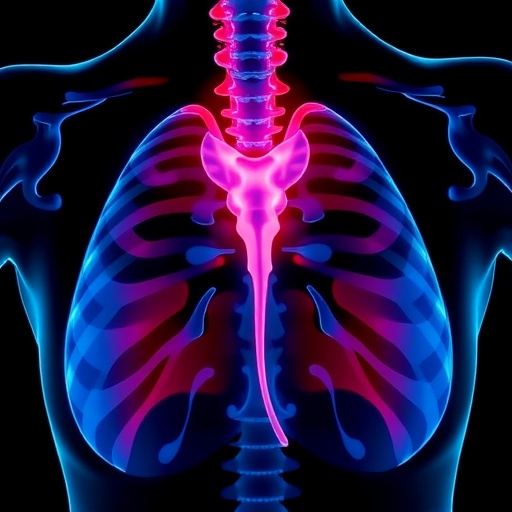A groundbreaking study published in BMC Cancer uncovers a compelling link between long-term exposure to fine particulate matter (PM2.5) components and increased breast cancer mortality in Inner Mongolia, China. This extensive research, encompassing over 17,000 female breast cancer patients from 2012 to 2021, utilized advanced statistical modeling to reveal how specific pollutants contribute to both the risk of death and the probability of remaining uncured. The findings offer vital insight into environmental impacts on cancer outcomes, emphasizing public health risks associated with air pollution.
The retrospective cohort study focused on six major constituents of PM2.5—black carbon (BC), ammonium (NH4+), nitrate (NO3-), organic matter (OM), and sulfate (SO4 2-)—and their correlations with breast cancer-specific mortality. Using daily pollutant concentration data combined with patient mortality records, the researchers applied a semiparametric mixture cure model. This sophisticated methodology allowed them to account for a cured subpopulation, thus providing more precise estimates of pollution’s effects on cancer prognosis.
One of the core revelations was an 8-year breast cancer cure rate of 93.6%, with the analysis confirming its statistical significance. However, exposure to PM2.5 components markedly altered this outlook. For each interquartile range increase in these pollutants, the odds ratios indicated a significant rise in the probability of patients remaining uncured. For instance, ammonium and nitrate components exhibited odds ratios exceeding 1.4, highlighting their substantial impact on reducing the likelihood of remission.
Additionally, hazard ratios assessing the relative risk of death underscored similar trends. Notably, ammonium and nitrate components increased mortality hazard ratios to nearly 1.5, indicating that exposure to these compounds intensifies the likelihood of fatal outcomes among breast cancer patients. The study’s data robustly supports the hypothesis that chronic contact with specific PM2.5 constituents exacerbates mortality risks beyond baseline health factors.
A critical strength of the research lies in its sensitivity analysis, which excluded patients categorized as severe cases to ensure the robustness of the associations. Even after filtering out these extreme cases, the link between PM2.5 and breast cancer mortality remained significant, bolstering confidence in the conclusions. This validation step is crucial for eliminating potential confounders that might skew the relationship.
Moreover, the study explores nonlinear dose-response relationships through advanced mixture cure models, unveiling that the risk of breast cancer death rises progressively with increased pollutant concentrations. These nonlinear insights provide nuanced understanding beyond linear assumptions and indicate potential thresholds where harmful effects intensify, with important implications for regulatory standards.
The components black carbon and organic matter, major byproducts of combustion and industrial emissions, also demonstrated significant associations with higher mortality and uncured probabilities. These findings draw attention to environmental carcinogens commonly found in heavily industrialized or urban areas, suggesting a direct pathway through which air quality deterioration may worsen cancer prognosis.
Geographically contextualizing the study, Inner Mongolia faces unique environmental challenges linked to industrial pollutants and ecological degradation. This regional focus amplifies the public health urgency, as vulnerable populations, including breast cancer patients, bear considerable risk from sustained exposure to hazardous airborne particles.
This study bridges environmental sciences and oncology, illustrating how long-term air pollution doesn’t merely contribute to cancer development but also profoundly influences survival outcomes. Traditionally, cancer prognosis focuses on genetic, clinical, and lifestyle factors, but these findings spotlight air quality as an environmental determinant deserving heightened attention in cancer care strategies.
Healthcare systems and policymakers can draw on these findings to implement targeted interventions in high-risk areas. Improved air quality standards, pollution mitigation, and patient risk assessments incorporating environmental exposure histories may become integral components of comprehensive cancer management in polluted regions.
Furthermore, these revelations pave the way for future research exploring biological mechanisms linking PM2.5 components with tumor progression and resistance to treatment. Understanding the cellular pathways affected by pollutant exposure could unlock new preventive and therapeutic avenues, potentially improving survival for breast cancer patients exposed to environmental toxins.
The study’s methodology, blending epidemiologic data with mixture cure models, offers a powerful template for investigating other diseases influenced by environmental factors. Its sophisticated design ensures more accurate differentiation between cured and uncured patient groups, advancing survival analysis techniques in public health research.
In conclusion, this pioneering research from Inner Mongolia spotlights a critical yet often overlooked determinant of breast cancer prognosis—ambient air pollution. Its evidence calls for urgent public health responses aimed at reducing PM2.5 exposures, especially in vulnerable patient populations, while reinforcing the interplay between environmental justice and cancer outcomes globally.
As industrial activities expand and urban air quality deteriorates worldwide, such insights are indispensable in informing policies that safeguard not only respiratory but also oncological health. This landmark study underscores the profound ripple effects of air pollution on cancer survival, challenging clinicians, researchers, and policymakers alike to re-evaluate environmental influences on disease trajectories.
With mounting evidence indicating the danger of PM2.5 components on breast cancer mortality, patient advocacy groups and environmental health experts now have a compelling basis to campaign for cleaner air as a vital dimension of cancer care. Ultimately, this integrative approach promises to improve the quality of life and survival rates of countless patients living amidst growing environmental hazards.
Subject of Research: Impact of long-term exposure to PM2.5 components on breast cancer-specific mortality and cure probability in Inner Mongolia, China.
Article Title: Long-term exposures to PM2.5 components increase the breast cancer mortality in the region of Inner Mongolia, China: a retrospective study based on mixture cure model.
Article References:
Zhou, J., Liang, B., Su, M. et al. Long-term exposures to PM2.5 components increase the breast cancer mortality in the region of Inner Mongolia, China: a retrospective study based on mixture cure model. BMC Cancer 25, 1465 (2025). https://doi.org/10.1186/s12885-025-14812-7
Image Credits: Scienmag.com
DOI: https://doi.org/10.1186/s12885-025-14812-7





